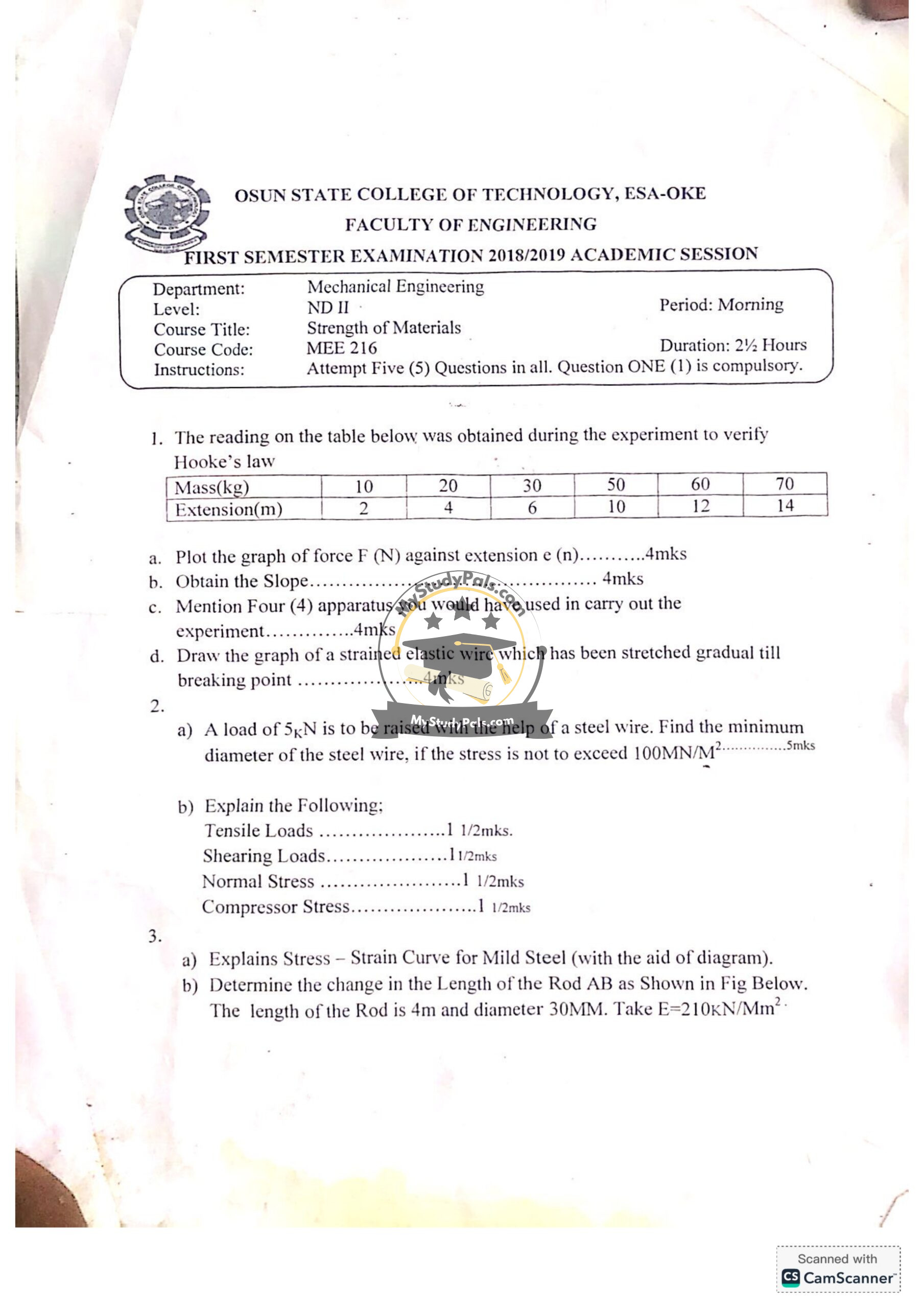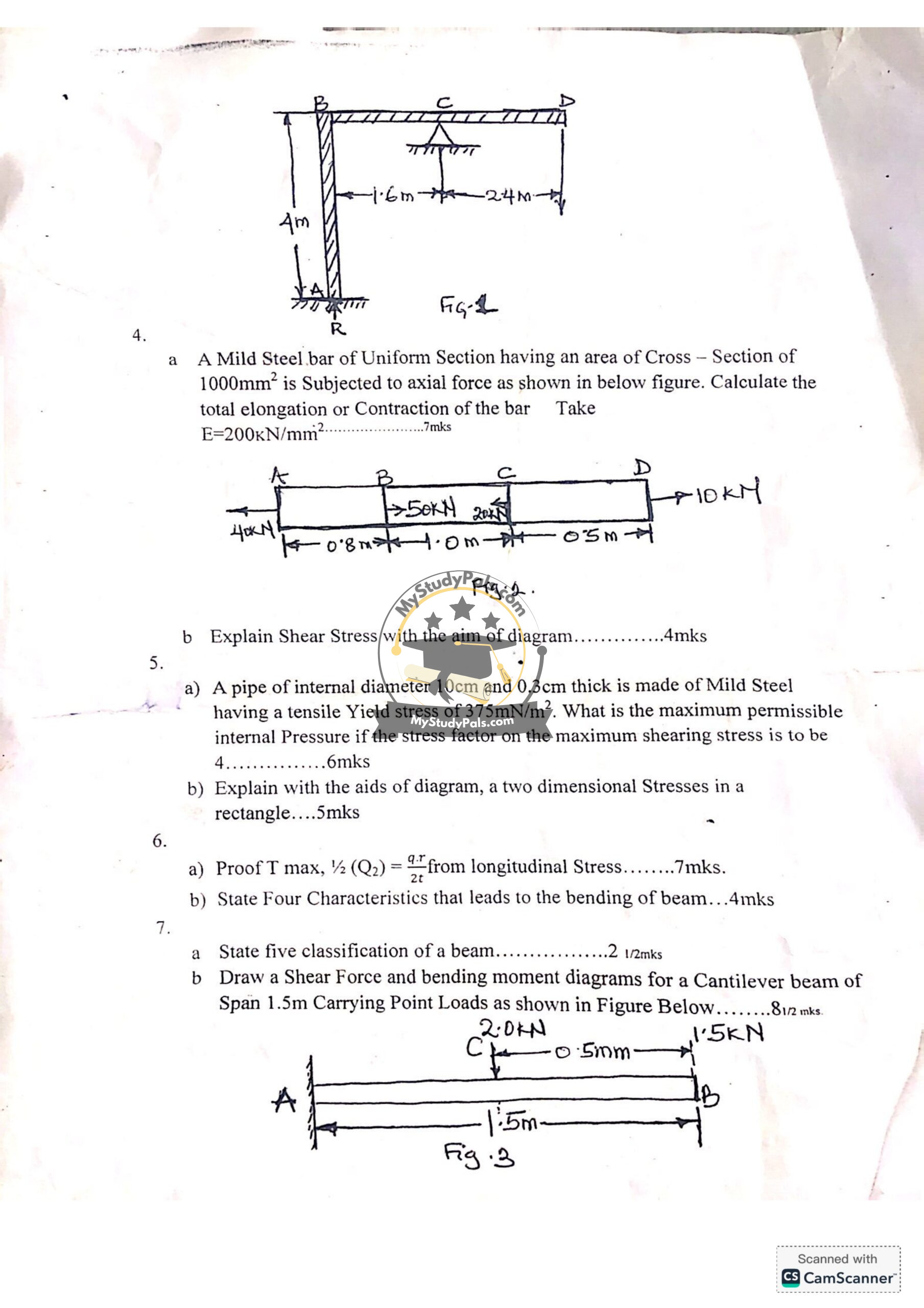ANWSER
Question 1:
a. Plot the graph of force F (N) against extension e (m)
- Convert mass (kg) to force (N) using F=mgF = mg, where g=9.81 m/s2g = 9.81 \, \text{m/s}^2.
- 10 kg → 10×9.81=98.110 \times 9.81 = 98.1 N
- 20 kg → 20×9.81=196.220 \times 9.81 = 196.2 N
- 30 kg → 30×9.81=294.330 \times 9.81 = 294.3 N
- 50 kg → 50×9.81=490.550 \times 9.81 = 490.5 N
- 60 kg → 60×9.81=588.660 \times 9.81 = 588.6 N
- 70 kg → 70×9.81=686.770 \times 9.81 = 686.7 N
- Plot these values on a graph with force (N) on the y-axis and extension (m) on the x-axis.
b. Obtain the Slope
- The slope of a Force vs. Extension graph is the stiffness kk (Spring constant).
- Using Hooke’s Law:
k=ΔFΔek = \frac{\Delta F}{\Delta e}
- Taking the first and last points:
k=686.7−98.114−2=588.612=49.05 N/mk = \frac{686.7 – 98.1}{14 – 2} = \frac{588.6}{12} = 49.05 \text{ N/m}
c. Mention Four (4) apparatus used in the experiment
- Spring or Elastic Wire
- Weights (Masses)
- Meter Rule
- Clamp and Stand
d. Draw the graph of a strained elastic wire stretched gradually until the breaking point
- The graph typically has three regions:
- Elastic Region: Linear portion where Hooke’s Law applies.
- Plastic Region: Non-linear behavior before breaking.
- Fracture Point: The point where the material fails.
Question 2:
a. Find the minimum diameter of the steel wire lifting a 5 kN load if stress is not to exceed 100 MN/m²
- Stress formula:
σ=FA\sigma = \frac{F}{A}
- Given F=5000F = 5000 N and σ=100×106\sigma = 100 \times 10^6 N/m²
- Area A=Fσ=5000100×106=5×10−5A = \frac{F}{\sigma} = \frac{5000}{100 \times 10^6} = 5 \times 10^{-5} m²
- Diameter from A=πd24A = \frac{\pi d^2}{4}:
d=4Aπ=4×5×10−53.1416≈0.00798 m=7.98 mmd = \sqrt{\frac{4A}{\pi}} = \sqrt{\frac{4 \times 5 \times 10^{-5}}{3.1416}} \approx 0.00798 \text{ m} = 7.98 \text{ mm}
b. Explain the following:
- Tensile Loads: Forces that stretch an object, increasing its length.
- Shearing Loads: Forces that cause layers of material to slide past each other.
- Normal Stress: Force per unit area acting perpendicular to the surface.
- Compressive Stress: Stress due to forces that reduce the volume of a material.
Question 3:
a. Explain the Stress-Strain Curve for Mild Steel
- A typical stress-strain curve includes:
- Proportional Limit (Linear region, obeys Hooke’s Law)
- Elastic Limit (End of reversible deformation)
- Yield Point (Start of plastic deformation)
- Ultimate Tensile Strength (UTS) (Maximum stress material can withstand)
- Fracture Point (Breakage occurs)
b. Determine the change in length of a rod (4m length, 30mm diameter, E=210E = 210 kN/mm²)
- Using the formula:
ΔL=FLAE\Delta L = \frac{F L}{A E}
- Assume force FF is given or can be inferred from context.
Question 4:
a. Calculate the total elongation of a Mild Steel bar (Area = 1000 mm², E=200E = 200 kN/mm²)
- Use:
ΔL=FLAE\Delta L = \frac{F L}{A E}
- Assume force and length values from diagram.
b. Explain Shear Stress with a diagram
- Shear stress τ=FA\tau = \frac{F}{A}, where FF is force parallel to the surface.
Question 5:
a. Find the maximum permissible internal pressure for a mild steel pipe (10 cm diameter, 0.3 cm thickness, Yield stress 375 MN/m², Safety factor = 4)
- Formula for hoop stress:
σ=Prt\sigma = \frac{P r}{t}
- Solve for PP.
b. Explain two-dimensional stresses in a rectangle with a diagram
- Stresses acting along two perpendicular directions, e.g., in a rectangular cross-section.
Question 6:
a. Proof of Tmax=qr2tT_{\text{max}} = \frac{qr}{2t} from longitudinal stress
- Derivation involves equilibrium of torsion in circular sections.
b. State four characteristics leading to beam bending
- External loads
- Material properties
- Cross-sectional shape
- Support conditions
Question 7:
a. State five classifications of beams
- Simply supported beam
- Cantilever beam
- Overhanging beam
- Fixed beam
- Continuous beam
b. Draw shear force and bending moment diagrams for a cantilever beam (1.5m span, point loads at 0.5m and 1.5m)
- Shear Force Diagram (SFD): Stepwise changes due to point loads.
- Bending Moment Diagram (BMD): Parabolic or linear changes depending on loading points.



